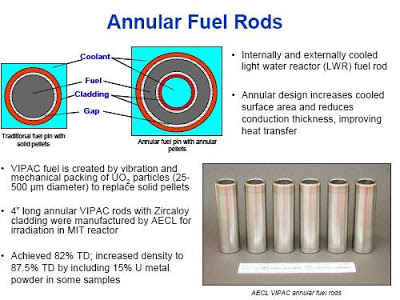The USA avoids 700 million tons of CO2 from the 800 billion kwh of nuclear power that are generated from standard nuclear plants.
1. A program to accelerate the research and development of annular fuel [ultra-uprates] (MIT, Westinghouse) to allow for 50% power increase to existing nuclear reactors with ultra-uprates. (beyond the traditional power uprates of up to 20%. This could be achieved with research budget allocation and policy changes to ensure prompt deployment. Full deployment in the United States would be avoid about 300 million tons of CO2/year. (30% boost to boiler water reactors.) Full deployment worldwide would avoid 1 billion tons of CO2/year.
Annular fuel ultra uprate economics are discussed in this nextbigfuture article
2. The USA needs to adopt the Idaho national lab plan for conventional nuclear reactors.
Speeding the build out of nuclear reactors. China is adding 77GW of new nuclear power from now to 2020. The US can accelerate the buildout of nuclear power plants (currently on track for 4-8 by 2020). Politically possible fast tracking would be about 10 nuclear reactors.
Stretch Goals:
1. Life extension of the current fleet beyond 60 years (e.g., what would it
take to extend all lives to ~80 years?); and
2. Strong, sustained expansion of ALWRs throughout this century (e.g., what
would it take to proceed uninterrupted from first new plant deployments in
~2015 to sustained build-rates approaching 10+/year?).Achieving a build rate of 10 plants per year, which on a sustained basis equates to about 50 plants under construction at any point in time, will require substantial investment in workforce training and new or refurbished manufacturing capability.
3. Develop factor mass produced deep burn nuclear reactors
A list of eleven fusion and fission technologies to develop.
In terms of transportation:
4. Deploy electric bikes (free like Amsterdam) and also have electric buses/vans for ensuring that people and the free electric vehicles have optimal logistics
China makes and adds 20-30 million electric bikes and scooters each year. 100 million peddle bike sales worldwide. China has 450 million peddle bike users.
5. X prize program for the retrofitting of existing vehicles for fuel efficiency. Aerodynamic retrofit of existing vehicles can enable 30% reduction in highway driving fuel usage. Need to have prizes for figuring out deployment that makes economic sense that people will adopt.
Aeromodding cars for higher mileage
6. there is a computer system that works with cruise control (developed in the UK by Sentience) and GPS which allows for proper computer controlled/assisted acceleration and breaking for 5-24% more fuel efficiency. Basically computer assisted hypermiling.
Policy to force the aerodynamic and engine retrofits of high mileage vehicles likes cabs and other high mile fleet vehicles.
7. Carbon sequestering in cities by using carbon absorbing cement.
8. Previous list of major CO2 mitigation methods.
Biochar sequestering, Regular Carbon Sequestering, CO2 Capture from the Air – for Fuel or Storage
Gigaton Throwdown
The Gigaton Throwdown, a project by Sunil Paul. Mr. Paul started the project under the auspices of the Clinton Global Initiative on Stabilizing the Climate. He organized a fairly large group of venture capital companies, some from the renewable energy sector, and some academic and think tank policy analysts, all concerned about climate change and the need for dramatic action to mitigate such change.
The Gigaton Throwdown defined, briefly:
“The Gigaton Throwdown, launched in 2007 at the Clinton Global Initiative by Sunil Paul, is a project to encourage entrepreneurs, investors and policy makers to plan to grow companies to a scale that they change the climate. The project is evaluating a portfolio of cleantech pathways that could lead to 1 gigaton per year of CO2-equivalent reduction by 2020, and the implications for capital, policy, and industry. The pathways currently in analysis are solar PV, solar thermal, wind, biofuels, nuclear, geothermal, plug-in hybrid electric vehicles, and buildings.”
The Gigaton Throwdown report was released June 24, 2009 in Washington DC.
For more background data and analyses behind the final report.
For more background on the Clinton Global Initiative at which the Gigaton Throwdown was launched.
You will note that Dr. John Holdren, Science Advisor to President Obama, was a lead participant in this particular Clinton Global Initiative meeting.
McKinsey consulting had a plan and an analysis of ways to avoid CO2.
1. Energy efficiency in buildings and appliances (710-870 megatons of carbon)
2. More fuel efficient vehicles (340-660 megatons of carbon)
3. Industrial efficiency (620-770 megatons)
4. Bigger carbon sinks (like more forest) (440-580 megatons)
5. Less carbon intensive power generation (800-1570 megatons)
This last one is more nuclear power and renewables and cleaning up coal.

Brian Wang is a Futurist Thought Leader and a popular Science blogger with 1 million readers per month. His blog Nextbigfuture.com is ranked #1 Science News Blog. It covers many disruptive technology and trends including Space, Robotics, Artificial Intelligence, Medicine, Anti-aging Biotechnology, and Nanotechnology.
Known for identifying cutting edge technologies, he is currently a Co-Founder of a startup and fundraiser for high potential early-stage companies. He is the Head of Research for Allocations for deep technology investments and an Angel Investor at Space Angels.
A frequent speaker at corporations, he has been a TEDx speaker, a Singularity University speaker and guest at numerous interviews for radio and podcasts. He is open to public speaking and advising engagements.


